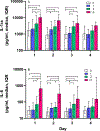A Targeted Analysis of Serial Cytokine Measures and Nonpulmonary Organ System Failure in Children With Acute Respiratory Failure: Individual Measures and Trajectories Over Time
- PMID: 37195096
- PMCID: PMC10524322
- DOI: 10.1097/PCC.0000000000003286
A Targeted Analysis of Serial Cytokine Measures and Nonpulmonary Organ System Failure in Children With Acute Respiratory Failure: Individual Measures and Trajectories Over Time
Abstract
Objectives: There is a need for research exploring the temporal trends of nonpulmonary organ dysfunction (NPOD) and biomarkers in order to identify unique predictive or prognostic phenotypes. We examined the associations between the number and trajectories of NPODs and plasma biomarkers of early and late inflammatory cascade activation, specifically plasma interleukin-1 receptor antagonist (IL-1ra) and interleukin-8 (IL-8), respectively, in the setting of acute respiratory failure (ARF).
Design: Secondary analysis of the Randomized Evaluation for Sedation Titration for Respiratory Failure clinical trial and Biomarkers in Acute Lung Injury (BALI) ancillary study.
Setting: Multicenter.
Patients: Intubated pediatric patients with ARF.
Interventions: NPODs were evaluated against plasma IL-1ra and IL-8 levels on individual days (1 to 4 d after intubation) and longitudinally across days.
Measurements and main results: Within the BALI cohort, 432 patients had at least one value for IL-1ra or IL-8 within days 0 through 5. 36.6% had a primary diagnosis of pneumonia, 18.5% had a primary diagnosis of sepsis and 8.1% died. Multivariable logistic regression models showed that increasing levels of both plasma IL-1ra and IL-8 were statistically significantly associated with increasing numbers of NPODs (IL-1ra: days 1-3; IL-8: days 1-4), independent of sepsis diagnosis, severity of oxygenation defect, age, and race/ethnicity. Longitudinal trajectory analysis identified four distinct NPOD trajectories and seven distinct plasma IL-1ra and IL-8 trajectories. Multivariable ordinal logistic regression revealed that specific IL-1ra and IL-8 trajectory groups were associated with greater NPOD trajectory group ( p = 0.004 and p < 0.0001, respectively), independent of severity of oxygenation defect, age, sepsis diagnosis, and race/ethnicity.
Conclusions: Both the inflammatory biomarkers and number of NPODs exhibit distinct trajectories over time with strong associations with one another. These biomarkers and their trajectory patterns may be useful in evaluating the severity of multiple organ dysfunction syndrome in critically ill children and identifying those phenotypes with time-sensitive, treatable traits.
Copyright © 2023 by the Society of Critical Care Medicine and the World Federation of Pediatric Intensive and Critical Care Societies.
Conflict of interest statement
Drs. Dahmer’s, Quasney’s, Curley’s, and Flori’s institutions received funding from the National Heart, Lung, and Blood Institute. Dr. Dahmer’s institution received funding from the National Institute of Child Health and Human Development. Drs. Dahmer, Quasney, Sapru, Curley, and Flori received support for article research from the National Institutes of Health. Dr. Flori disclosed that she is a Board member of Michigan Thoracic Society, Executive Committee Board member of Pediatric Acute Lung Injury and Sepsis Investigators, Taskforce member for Lancet, and a Taskforce member for Society of Critical Care Medicine. The remaining authors have disclosed that they do not have any potential conflicts of interest.
Figures



References
-
- Erickson S, Schibler A, Numa A, et al.: Acute lung injury in pediatric intensive care in Australia and New Zealand: A prospective, multicenter, observational study. Pediatr Crit Care Med 2007; 8:317–323. - PubMed
-
- Flori HR, Glidden DV, Rutherford GW, Matthay MA: Pediatric acute lung injury: prospective evaluation of risk factors associated with mortality. Am J Respir Crit Care Med 2005; 171(9):995–1001. - PubMed
-
- López-Fernández Y, Azagra A, de la Oliva P, et al.: Pediatric Acute Lung Injury Epidemiology and Natural History study: Incidence and outcome of the acute respiratory distress syndrome in children. Crit Care Med 2012; 40:3238–3245. - PubMed
Publication types
MeSH terms
Substances
Grants and funding
LinkOut - more resources
Full Text Sources
Medical

